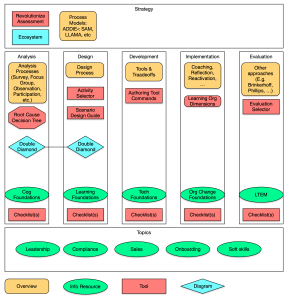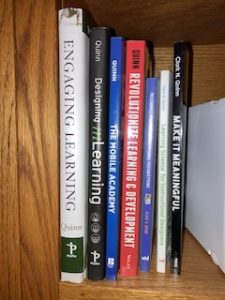I have a cobbled together tech environment. My monitor and printer are years old, and my laptop is relatively new. To make them fit together, particularly with the limited ports of a laptop, I’ve a hub. And, now a few weeks ago, things went wonky. In weird ways. And I still don’t know it all, but there are some lessons here, not least the illusion of (my) competency. We all have travails, but this one has some lessons.
So, the first symptom was my microphone suddenly not working. I’d gotten a reasonable one, but it died (and apparently wasn’t good enough anyway), so my co-director in the LDA, Matt Richter, got me a nice one. It was this fancy, heavy one, that stopped working. It’s USB, so has LEDs, which are blue normally but green when in use. Except what happened was that when I wanted to use it, it started not working and blinking between blue and green. Hold that thought.
Then, the camera in my monitor stopped working. I have one in my laptop that’s better/newer, but it’s a bit away (I prefer to work on the big monitor, of course). I use the laptop camera when I want to look impressive and show my book case beside me ;). But I prefer the monitor camera for work meetings and the like. Yet, I couldn’t. Now hold that thought, too!
The icing on the proverbial cake came when my backup drive stopped backing up. It would start, and say it was finding probs, but then would time out with an error. I tried to run diagnostics, which said it was corrupt. I also got SMART results saying it was fine. All very confused.
Finally, I decided I had to contact Apple (fortunately Matt’s also insisted I keep up my service plan). After a lot of shenanigans that I won’t bore you with, the question came: is my hub powered? As it was, the answer’s no. If memory serves (dodgy proposition), I got it for free when Amazon was experimenting with providing things to people who wrote reviews. Which would be a weird issue, as I’d been using it for several years this way.
Still, went and ordered a powered hub. Then ordered another, realizing I wanted the faster version. BTW, I had to pick up both, because the other was fulfilled before I got the second, and the solution seemed to be that I picked up both and returned the first. Which took an extra 5 minutes, apparently to defend against fraud. Why we can’t have nice things…(Lesson: allow people to cancel orders via chat or online, don’t make them come in, take and immediately return).
While I was dealing with the hub, I decided to call the maker of the microphone (remember?). I’d called them before and left a message, and also emailed, to no reply. (Lesson: return your customer queries.) I was leaving a voicemail when I got a call from them, so I switched. It turns out that the blinking means the mic’s muted. There’s a knob on the back that’s ‘gain’, BUT it turns out it’s also a button, and if you push it, it mutes the mic. Now, I’d gone to the site and the mic instructions, and it doesn’t talk about that at all! I mentioned it to the person on the phone, and they said that they’d tried to get it changed, to no avail. (Lesson: put all the information about operation in the <expletive deleted> documents!) Problem fixed.
Then, when I installed the powered hub, the video camera in the monitor started working again. It’s not clear why it suddenly stopped, but…it was fixed. The lesson here, and for me (tho’ feel free to take it to heart), is probably never to trust an unpowered hub to be sufficient. However, and in my defense, it had been working for months if not years. (And, if you could’ve told me that, I don’t want to hear it.)
Finally, we get back to the drive. The powered hub didn’t fix it. I spent an unreasonable amount of time trying to run diagnostics, both Apple’s and the manufacturers. Finally, I delisted it from the backup software, erased it, then reintroduced it. And, voila’, it’s working! Not sure what the problem was. (Lesson: provide more feedback to the user on what’s going on.)
As a weird aside, I asked for a support call, but when it came it shut off my wifi calling. I live in a slight depression and have a bad signal, so I use wifi. But by turning it off, they ensured that the call would get dropped. I can’t imagine why they would do such a thing, but I’ve had real trouble getting calls from them, and this time just happened to see that the wifi calling had stopped at the time of the call. I had to use chat. Very puzzling and unresolved.
All told, this took way too much time, and while I learned one lesson, there was too much the result of bad design, not incompetence. As Don Norman said in The Design of Everyday Things, if it’s difficult to use, blame the designer, not the user. We know how to do better, we just don’t do it frequently enough. (I also recommend Kathy Sierra’s Badass as a guiding light.) I’m willing to assume responsibility for my culpability, and admit to the illusion of (my) competency. But I also recognize that I’m not stupid, and better design would’ve limited my frustrations and time wasting.


